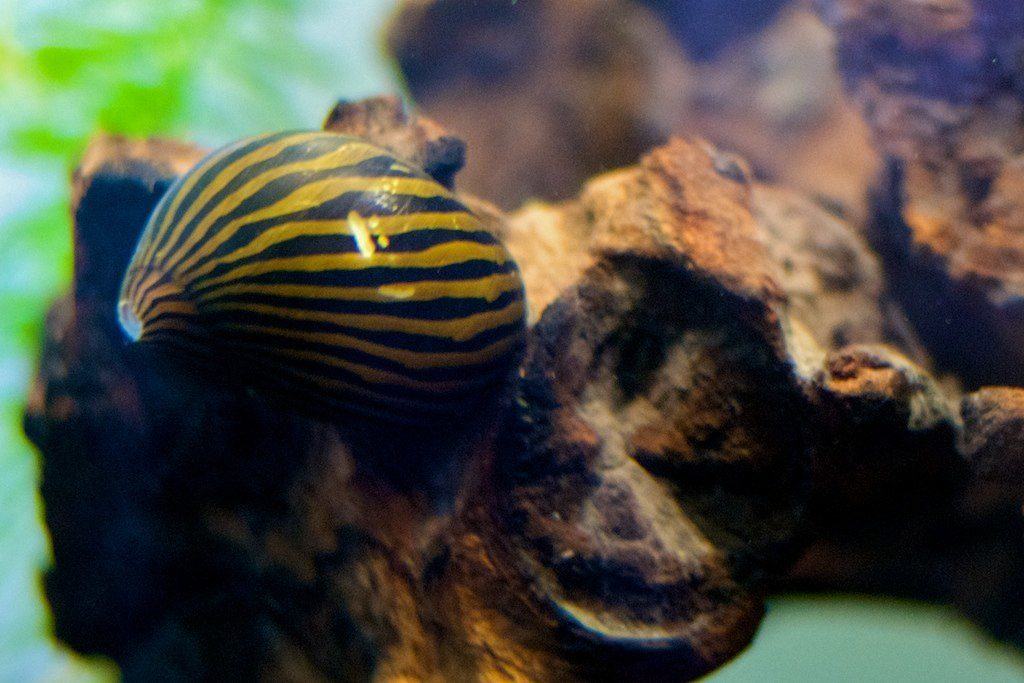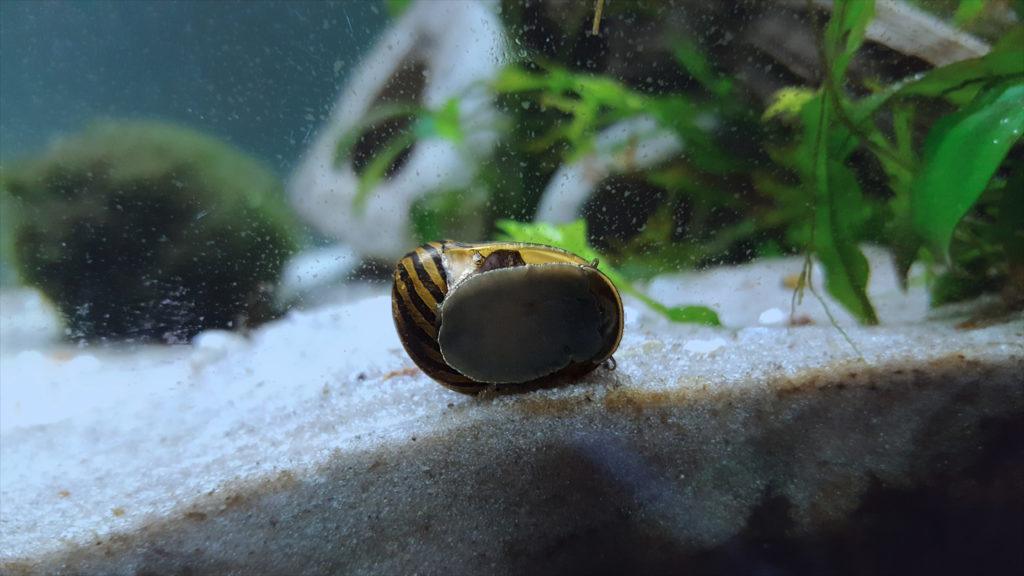When you’re filling a home aquarium, snails are not the first occupants that come to mind. Snails, though, can prove excellent additions to any aquarium, so long as you take their personalities and those of their tankmates into account.
The zebra nerite snail is an especially companionable subspecies of snail. Their coloring makes them distinctive among the habitat of a tank, and so long as they’re not in the company of natural predators, they can live peaceably among any sort of fish.

You can bring a cluster of zebra snails into a pre-existing tank (so long as the habitat is kind to them) or establish them in a tank of their own. Either way, these snails will provide a welcomed change of pace to the average home aquarium.
Even so, the care and keep of the zebra nerite snail demands as much attention as the keeping of any other species of snail or fish.
Consult this guide for a full understanding of the zebra snail’s needs, and you’ll find yourself more than capable of creating a positive and healthful environment for these snails to live in.
Contents
Zebra Nerite Snails Personality and Appearance
Appearance
Zebra nerite snails are one of many subspecies of nerite snails, also known as tiger nerite snails due to the striped black and gold coloring of their shells. This unique and stark coloring makes them easy to find in any home aquarium.
In fact, zebra nerite snails are some of the best snails to keep in captivity, not only because of their bright coloration, but because of their diet. Zebra nerite snails consume algae and waste that gathers at the bottom of your home aquarium at a notorious rate.
Personality
They can be raised in either fresh or salt water, but they only reproduce when in a brackish environment.
Further, they are a tidal snail, which means that they can live outside of the water for extended periods of time. This is lucky; even though the zebra nerite snail is fantastic to raise on your own, the nerite species has a tendency to travel.
More often than not, these snails will try and escape their aquariums, not to fulfill a sense of adventure or to escape stressful stimuli, but simply because it is in their nature.

Nerite snail care, then, may be reasonably straightforward, but that doesn’t mean that it’s a process that doesn’t require thought or care.
When you bring a cluster of zebra snails into your home, you have to be sure to take care of their needs, same as any other pet.
They may not beg for treats, but they’ll still provide you with some interesting stories and an excellent daily view.
Nerite Snail Care
Statistics
A quick overview of the zebra snail is enough to give you a general understanding of how they live – but learning how to care for the species takes more attention to detail than that.
Let’s get down to the nitty-gritty.
- Preferred pH levels: 5 to 8.5.
- Temperature Range: 65 to 85 degrees Fahrenheit.
- Water Type: kh 12-18.
- Water Hardness: Moderately Hard.
- Average Size: Less than one inch.
- Aquarium Size: 10 gallons – 30 gallons, minimum.
- Sensitivities: Copper.
- Diet: Herbivores.
Natural Habitat
As previously stated, zebra snails can live in either fresh or salt water, but they can only reproduce in brackish water.
Their natural habitat, when not being kept in aquariums, sees the zebra snail living in the mouth of rivers, mangroves, and lagoons in Africa.
These snails can be most commonly found in Kenya, Somalia, and Tanzania, though they’ve been known to appear in the coastal lowlands of South Africa, as well.
The temperature weather of these areas, combined with the variety of water types, ensure that the zebra snails can reproduce, should they wish to, or live in relative peace.

These snails do have natural predators who scavenge for them while living in the wild. Wild betta fish, for example, will enthusiastically make a meal of a wild zebra snail. Still, zebra nerite snails are not an especially aggressive subspecies of snail when in the wild, nor when in captivity.
They prefer to live in communities and are not aggressive towards one another or towards any other creature that passes their way. Even so, the lifespan of a wild zebra snail can vary, ranging from a few weeks to two years.
Tank Habitat
Their versatility in the wild ensures that zebra nerite snails can live in just about any captive environment, so long as they are treated properly and all their needs are met.
These snails are quite often companions to larger schools of fish; as such, it’s usually best to take into account their companions’ tank size needs before solely addressing the zebra snail.
If you want to have a tank dedicated to your zebra snails, though, you might find yourself surprised by how much space they need.
At a minimum, a zebra snail tank needs to be ten gallons in size, though the snails tend to do best when given a large space to roam. A thirty-gallon tank will likely suit your zebra snails better.
Zebra snails do have a particular quality, though, that makes them a boon to any tank they’re put into, alone or amongst company.
When you have these snails around, you won’t need to buy a filter for your tank. Why? Zebra snails are algae eating snails.
If you introduce a filter into a tank with zebra snails inside, you will be depriving your snails of their primary source of food. This means that the keeping of zebra snails may save you money on tank maintenance, if not on food to keep the critters happy.
That said, zebra snails aren’t especially partial to plant life in a tank, nor do they need hiding places like some more timid breeds of fish do.
It’s advisable that a tank with zebra snails in it have a good pocket of air inside, though. Zebra snails are tidal snails; they can live outside of the water for a considerable amount of time and may benefit from the diversity of environment.

Do ensure, though, that the lid of the tank you put your zebra snails in is a tight one. If you’re not careful, you may find that your zebra snails like to sneak out.
All that said, zebra snails are still a relatively easy tank addition to care for. In some ways, they do you as much good as you do them: you provide them with a habitat, and they’ll keep it clean.
Nerite Snail Companions and Temperament
As touched on in the previous section, zebra snails are an especially docile subspecies of snail. They tend to travel, true, as instinct demands of them.
You’re more than likely to find them clinging to the side of your tank, though not out of boredom or overstimulation. The zebra snail is simply driven to travel. Their wandering tendencies might put them in the path of aggressive fish, though, should you choose to keep these snails in an aquarium with company.
Zebra snails do play well with others. It’s even been proposed that these snails live more healthily when exposed to a tank full of diverse life.
Do try and pair your zebra snails with non-aggressive fish, as they themselves won’t be a problem, but they will be presented as tantalizing prey to fish like the betta or the loach.
The African cichlid, too, will pose a dangerous tank mate, even though the snails and fish live in similar habitats.
Don’t prematurely shorten the nerite snail lifespan by bringing these fish into one of your zebra snail tanks; as much as the fishy companions may appreciate the in-tank escargot, you will not.
Instead, try for fish that live similarly peaceful lifestyles, like the fancy guppy or the green swordtail.
Feeding
It’s already been said that the zebra nerite snail eats the algae and waste within an aquarium, but you’re likely wondering, “What do nerite snails eat when there isn’t enough waste around?”
You can feed your zebra nerite snail a variety of different plant life, so long as you’re careful.

Blanched vegetables go over wonderfully with zebra snails, so feel free to share blanched kale, carrots, lettuce, broccoli, or zucchini with them.
Algae wafers can also substitute for actual algae in your tank. Overall, zebra snails are not especially picky eaters. So long as they have nutrients available to them, they’ll remain a contented part of your aquatic ecosystem.
Breeding
If you’re looking to breed your zebra snails, you’re in luck. Zebra snails defy biological snail norms and prove to be interesting creatures to have reproduce in your home aquarium.
Unlike most snails, zebra snails are gendered, meaning that there is a distinct difference in the sex organs of the male and female zebra snail. Most other types are hermaphrodites and can reproduce without a care.
Zebra snails, though, require not only a partner of a different sex, but the proper environment, too. Nerite snail breeding must take place in brackish or salt water, and it’s usually best that the water is calcium-rich as well. Furthermore, they’re more likely to breed when in a large group of other zebra snails.
It can be difficult to tell when the snails are actually in the process of breeding. You will be most likely able to tell if your attempts have been successful upon the appearance of nerite snail eggs.
These eggs will hatch into larvae without shells, and the snail fry will go into hiding until they have matured and grown the shells necessary to keep themselves safe from predators.
Here’s a video showing more information on nerite snails.
Do you have any tips on nerite snail care?

